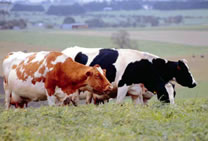Australian Dairy Production
Australian dairy cattle are managed on pasture with feed supplementation. This means that their milk production levels are on average, lower than reported production levels of cattle from traditional dairy producing countries such as the Netherlands, Germany, Canada and the US. Cows from these countries are fully fed large quantities of grain and high protein supplements and are able to maximise their productive potential because of their balanced, high energy, high protein, grain-based ration.
Australian Holstein Friesian cattle, bred along the same genetic blood lines as their counterparts in these northern hemisphere countries, cannot achieve these production levels while they are fed mainly on pasture.
Australian dairy cattle, however, are more selected for converting grass into milk than American, Canadian or European cattle. The low level of supplementary feeding means the production cost of a unit of milk in Australia is considerably less than it is for our overseas competitors.
Unfortunately, importers of dairy cattle tend to look for milk production in absolute terms, ignoring the feeding regimes and efficiencies of animals producing less milk under entirely different management systems. When examined in this context, Australian dairy cattle are ideal for the countries looking to develop their local dairy industry.
Potential customers can select Australian dairy cattle with the knowledge that they are likely to perform well in any environment. Environmental adaptability and selection for extensive grazing systems are important advantages exhibited by Australian dairy cattle.
Australian dairy cattle producers have access to the Australian Dairy Herd Improvement Scheme (ADHIS), which is one of the most advanced genetic performance and evaluation systems in the world.
